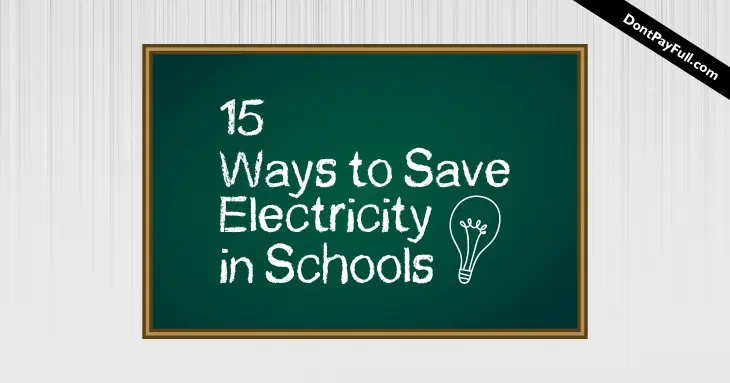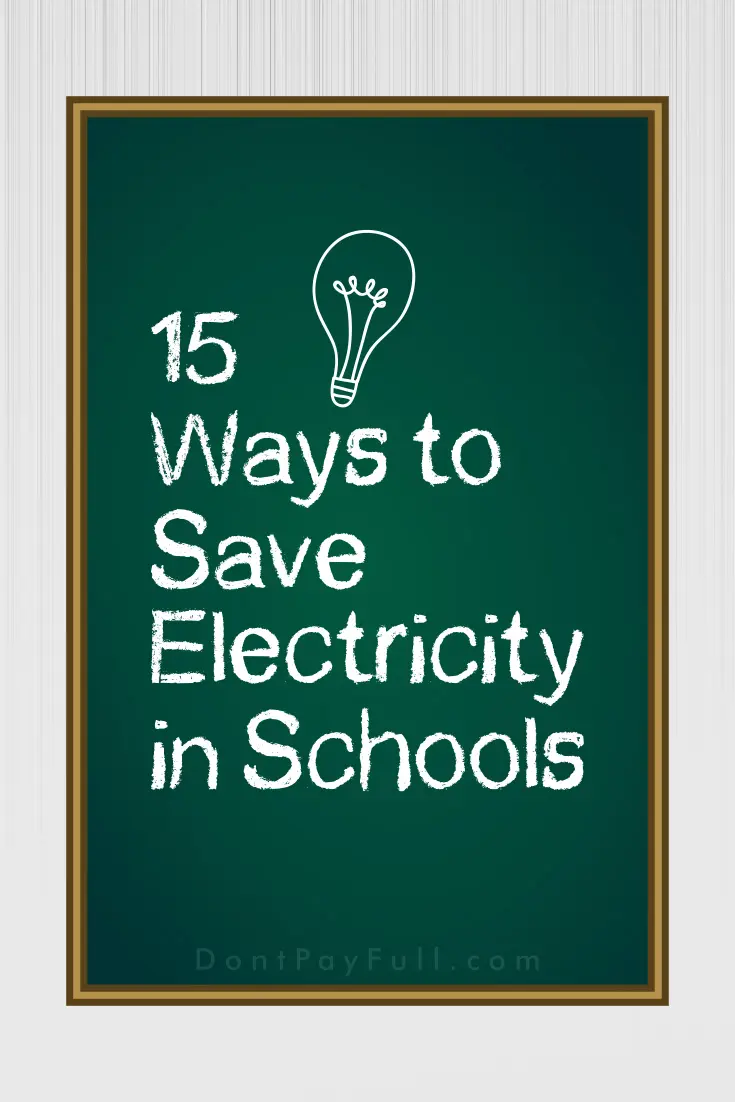A few decades back, having a greenhouse or office was considered more of a fad. You were ‘in’ if you have eco-friendly gadgets in the office, or if you are operating a paperless policy. At home, there are environmentally-friendly products that you can purchase for cleaning and other everyday tasks. Today, however, going green has become more of a necessity.
If you want to save electricity in schools, there are a few things you need to know:
People from all parts of the world have become aware of the negative impact that global warming has to the environment. The good side to this is that more and more businesses and homeowners are exerting serious efforts into reversing the negative effects of man’s bad habits to the environment.
Starting from practicing ways to conserve energy to exerting effort in conserving precious resources such as water, all these things combined should amount to a lot in the long run.
One place where everyone should start implementing ways to save electricity is at school. Since schools are a place of teaching and learning, it has become the perfect setting for spreading awareness about the ill effects of global warming to the environment.
When teachers impart knowledge about how kids can save electricity and water, they can take the skills that they have at home and also have an impact there. If they’re saving water and electricity both at home and at school, all the combined efforts will lead to a better place to live in, today and in the future.
Top 15 Ways to Save Electricity in Schools
Whether you’re a teacher, principal, guidance counselor or staff, you can put all your efforts together to save electricity in school. There’s really no one specific formula that you can follow in order to successfully conserve energy – be it at school or at home. But what does work is putting all the individual efforts together to experience great results.
This means that if each and every student in the school is aware of the many ways to conserve electricity and they are practicing it in school and at home, more energy will be saved.
Here are the top 15 ways to save electricity in schools:
1. Turn saving electricity into a group project.
As mentioned earlier, there’s no one magical formula when it comes to how electricity can be conserved. Instead, it’s a combination of individual and group efforts. The good news is that you can easily start small. If you’re the teacher of a class of kindergartners, for example, you can turn saving electricity into a group project.
Make a chart which shows a list of ways that kids can save electricity and water, both at home and in school. The language used should be age-appropriate, the tips should be practical, and the sign should be colorful to make it more attractive to the kids. Some of the items that you can include in the list are turning off the lights when no one is using them, not letting the water from the faucet flow while brushing their teeth or washing their hands, etc.
2. At the end of each school day, turn off all computers and screens.
For every desktop or laptop computer turned off after school hours, almost $100 is saved every year. Unfortunately, there are some school managements who do not exert the extra effort in ensuring that no computer is left on standby mode at the end of every school day.
To make this task easier, ask the kids themselves to shut down the computers that they are using at the end of each school day. The savings on your utility bills will be a lot when you enforce this simple policy.
3. Replace all traditional light bulbs with energy-saving ones.
Be it at home, in the office or at school, traditional light bulbs installed typically consume more energy than CFL bulbs. These energy-saving bulbs can cut back your electrical consumption for lighting by as much as 75%. If you have old fluorescent light fittings, these can be upgraded to high-frequency models which also help save energy.
4. Maximize natural lighting by controlling the blinds and lights.
Another light-related tip for conserving electricity in school is to control the way that blinds and lights are used. If you wish to maximize natural lighting, you can simply open the window blinds. As long as there is enough daylight, the students should be able to see the entire classroom without having to use artificial lighting, especially during the day.
During bleak days when sunlight cannot be maximized, making sure that all the light fixtures are cleaned is the best way to ensure the brightness of the artificial lights.
5. Switch off before the holidays, weekends and mid-term breaks.
During weekends, mid-term breaks and long holidays, it is a must to ensure that all the electrical appliances are switched off. If you leave even just one lighting fixture open and nobody’s at school to turn it off, you will be wasting electricity unnecessarily. Just before the break, make sure that printers, projectors, computers, lights, water heaters, boilers and all the other school equipment are turned off.
6. Use time clocks to switch everything off automatically after classes.
After a one-hour Mathematics class, the teacher might forget to turn off the lights, fans or air conditioning unit inside a classroom. If this happens and no class will be occupying the room afterwards, a lot of electricity will be wasted.
A good solution for this would be to use time clocks. These are inexpensive gadgets which can be used to switch off energy-consuming items after a specific time frame. If you want the time clocks to also automatically shut everything off during the weekends, look for 7-day instead of just the 24-hour time clocks.
7. See to it that each classroom has an efficient cooling and heating system.
For homes, schools and offices, half of the utility bills comprise of cooling and heating costs. In school, your number one priority should be to make sure that the temperature is comfortable for the students, whether it is summer or winter. This means that you have to make sure that the heating and cooling system inside the room and the entire school is efficient.
If a classroom is too hot, for example, do not open the window but turn down the thermostat instead. If night classes are held at school, schedule the room arrangements to be in one wing so that you can save money on heating costs.
8. Make it a student project to keep records of meter readings.
One of the many skills that teachers can impart on their students is reading the meter. After getting the kids to learn how to read electric, gas, oil and water meters, you can all record and monitor the results. If you implemented a save-electricity-policy this month, check how many kilowatt-hours will be deducted next month based on the meter readings. This is a great way to save electricity in school, while teaching kids useful skills at the same time.
9. Teach kids to conserve water, too.
While you’re at it, why not teach the kids how to save water, too? Most of the tips that you can teach are things that they can do inside their own homes, like turning the tap off while they are brushing their teeth.
On the school management’s side, repairing leaking taps, installing water displacement devices, turning off urinals during the holidays and monitoring the reading on water meters are some of the ways to conserve water.
10. Pay attention to the school’s insulation.
Again, heating and cooling costs make up half of a school’s utility bills. To make sure that no cooled air escapes during summer, have cavity walls filled with insulation. The investment in such projects will be worth it in the long run because of the amount of energy that can be saved.
11. See to it that the staff in the pantry are using electricity and water efficiently.
The pantry area is where electricity and water will be used the most, so you should make sure that the kitchen staff knows how to conserve both. Using tight-lidded pots and pans, only cooking food on suitable-sized cookers and thawing frozen foods at room temperature instead of putting them under running water are some of the things that can be done to save water and electricity in the kitchen.
12. Use skylights in common areas.
In between classes, students usually gather together in one area to socialize and study. Instead of using artificial lights, have skylights installed in these areas so that you can maximize the use of the sun’s light.
13. Set a schedule for regular monitoring and repairs of timers and other energy-saving devices in school.
During weekend or summer breaks, set a schedule to monitor and repair energy-saving devices in school. Clean fans, lights and refrigerator coils. Replace filters on air conditioning units. Check on water leaks in all the bathrooms and faucets. Check if all the timers are working. Doing such maintenance tasks will ensure that no electricity or water will be wasted once the kids go back to school.
14. Teach the students about alternative energy sources.
You can also teach kids about alternative energy sources like solar, wind, geothermal or hydroelectric.
15. Close rooms which are not being used to eliminate unnecessary heating and cooling costs.
Lastly, cut back on your school’s electricity consumption by closing off rooms which are not in use. When you combine all these seemingly small efforts together, it will result to a lot of savings on electricity. Not only that, but you can also teach the students the invaluable lesson of needing to conserve water and energy.
This is something that they can take home with them so that once they are out of the school area, they will still be responsible citizens who are doing their best in helping save the environment by conserving water and energy.
Pin it for later:










